How Long Do Hawks Live? Lifespan Mysteries Uncovered
Hawks are birds of prey species that can live anywhere, whether in deserts, fields, mountains, or moist or tropical areas. They play a vital role in the ecosystem by controlling the small mammals, rabbits, and rodent populations. Thus, their high mortality can cause an imbalance in the food chain.
So, how long do hawks live? On average, they can live up to 12 years in the wild. Most of them die before reaching 5 years in the wild. Yet, in captivity, they may live as long as 20 years. You can also find multiple records of them living till their 30s.
Throughout the article, we will discuss their longevity and the factors responsible in this regard. To know more, please tag along till the end.
How Long Do Hawks Live? The Average Lifespan Of A Hawk
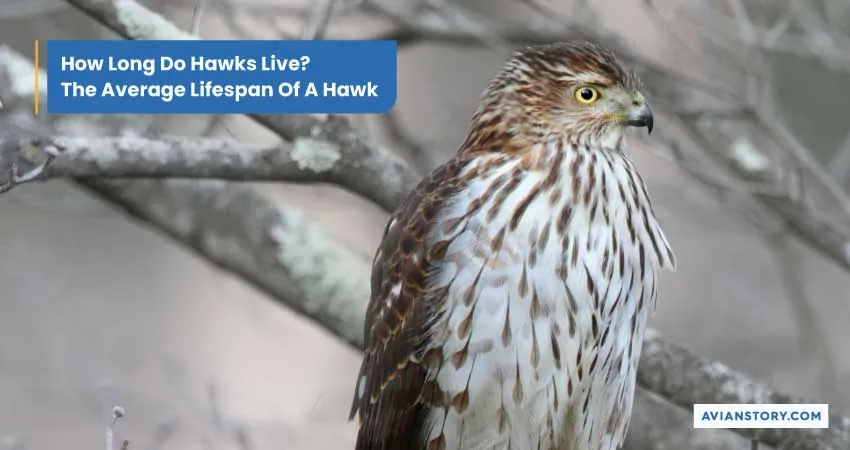
Generally, in captivity, a hawk can live up to 20 years; even some can live till their 30s. But if you consider their lifespan in the wild, it will be lower than their captivity. Usually, in captivity, they may live up to approximately 12 years.
In the wild or captivity, they can live more or less than their expected life span, depending on several factors. Those factors will mostly differ in the wild and captivity.
In the wild, these are the factors that will affect their average lifespan:
- Species
- Genetics
- Availability of food sources
- Habitats
- Diseases and parasites
- Environmental factors
- Threat from mankind
- Predation
- Accidents
In captivity, you need to monitor the following factors as they affect their average lifespan:
- Proper breeding
- Diet and nutrition
- Size of housing and enclosure
- Interaction with human
- Proper handling
- Adequate enrichment
- Stress
- Veterinary cares
How Does Lifespan Vary Among Different Hawk Species?
There are almost 200 species of hawks and their lifespan varies from each other. Numerous factors are responsible for this variance. Let’s know in detail:
Comparison Of Lifespans Among Various Hawk Species
Here are the differences in their life span among several common species of this birds of prey:
| Species | Lifespan in the wild (years) | Lifespan in captivity (years) | Maximum Recorded lifespan (years) |
| Red-tailed hawk | 10-15 | 20 | 33 (in captivity) |
| Cooper’s hawk | 10-12 | 20 | 20 (in the wild) |
| Sharp-shinned hawk | 3-5 | 13 | 19.9 (in captivity) |
| Harris hawk | 10-12 | 20-25 | 38 (in captivity) |
| Ferruginous | 8-15 | 20-30 | 24 (in the wild) |
Why Certain Species Live Longer Than Others?
Here is an analysis of why certain species may live longer than others:
- Size And Metabolic Rate: The larger hawk species will have a lower metabolic rate than the smaller species. As a result, you will find them to age slower and live longer than the smaller species.
That’s why the sharp-shinned species has a smaller lifespan than the red-tailed or ferruginous hawk species. The ferruginous is the largest hawk in the world, and the red-tailed species is the second one.
- Predation risks: The larger size of hawks generally occupy the top position in the food pyramid. As a result, they have fewer natural predators than those of smaller species. That’s why they will live longer.
- Genetic Factors: Some species may have genetic traits that provide excellent resistance to diseases. Besides, genetics can also lead to a slower aging process and better physiological adaptations.
Some larger species can get larger brain sizes genetically. Generally, this larger brain size refers to longer lifespans.
- Reproduction rates: Generally, species with slower reproductive rates and fewer offspring potentially have longer lifespans. With slower reproductive rates, parent hawks will invest more energy and time in parenting.
As a result, the survival rate of their offspring will also increase.
What Factors Influence the Lifespan of Hawks in the Wild?

These birds of prey need to encounter numerous threats and harsh weather in this wild. The following factors reduce their life expectancy in the wild:
Diet And Food Availability
If the food sources become scarce, the competition among them or with other raptors will also increase and vice versa. Under intense competition, their stress level will increase for adequate food. This will also be responsible for their shorter lifespan.
You may notice some raptor birds hunting both day and night, ensuring an adequate food supply. But do hawks hunt at night? Generally, they are diurnal and hunt during the day or in low light.
Though they can’t usually hunt on nights, they can hunt on moonlit nights. This will help them enrich their diet list with diurnal and nocturnal species. Also, this will reduce their food scarcity and the complexity of survival.
Predators
Though hawks prey on small mammals or birds, they also have groups of predators. So, what animal eats a Hawk? Generally, a raccoon, fox, or owl can eat a hawk.
Moreover, you may find many human hunters to hunt them. But why will humans predate them? Are hawks dangerous to humans?
They are not directly dangerous to humans, but they can eat up the ducklings and chickens of farmers. Thus, to reduce the loss, farmers can intend to shoot hawks.
Environmental Factors
Environmental factors like climate change can cause natural calamities, which may damage their natural habitats. Natural calamities can cause a reduction in nutritious food sources or an increase in competition for foods.
Besides, extremely harsh weather can also change the abundance and distribution of their prey. Eventually, this will also affect their survival and longevity.
Diseases
Diseases like West Nile virus, avian influenza, and aspergillosis are mostly responsible for high mortality in hawks. The cooper and red-tailed hawk species are the prime victim of the West -Nile virus.
Also, you can see hawks using the same nest year after year until the nest doesn’t get damaged. This increases the parasitic load like lice and mites in those hawks nesting. As a result, this will also cause the death of a huge amount of nestlings.
Injuries
Hawks can get involved in inter-species or intra-species fights due to competition for food. During those fights, they can get severe injuries that may cause death or reduce their vitality.
Also, you may have seen them getting hit by cars while flying. Moreover, they may sometimes die in electrocution when perching on high-voltage power lines.
Migration
Hawks are migratory birds, but when do hawks migrate? You may notice most of the species migrating in October. Yet, depending on weather conditions, their migration timing ranges from September to mid-November. Here are some effects of migration on their longevity:
- If they can’t find suitable habitats with abundant food sources, they may die due to starvation.
- They can encounter harsh weather conditions, predations, or collisions during migration.
- Also, they come in contact with individuals from different regions. This increases the risk of disease transmission.
- Migration will have significant energy expenditure and put a strain on their bodies. Thus, it may even be the reason for weaker individuals’ mortality.
How Does Captivity Influence the Lifespan of Hawks?
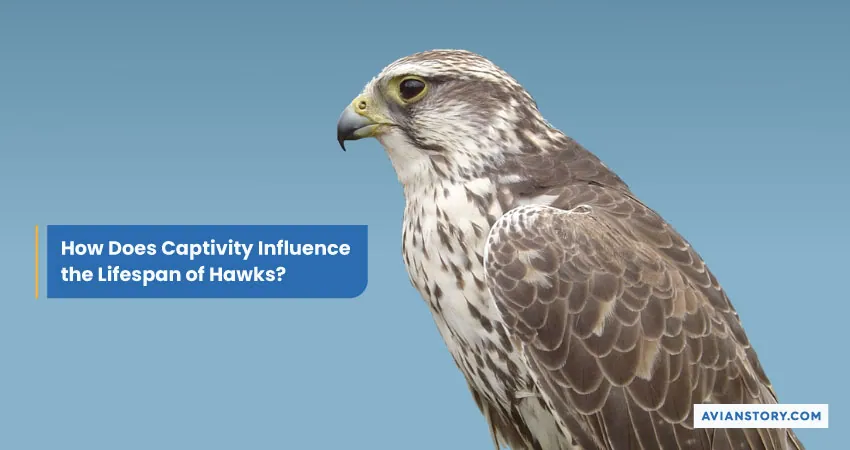
In captivity, this predatory bird species will live longer than in the wild. But in the wild, most of them die before 5 years due to high natural threats and environmental challenges.
Advantages Of Captivity For Hawks
Let’s see the advantages of captivity for these birds of prey:
- They get a better supply of food and nutrition yearly in captivity.
- They are no longer exposed to collision with moving vehicles or electrocution with power lines.
- Their breeding success is also higher in captivity with adequate food supply and care.
- They won’t need to face harsh weather and natural threats.
- They get regular veterinary treatment. This will also reduce their rate of mortality due to diseases.
Disadvantages Of Captivity For Hawks
Here are some disadvantages of captivity for these predatory birds:
- Lack of hunting opportunities and physical activity will reduce their cardiovascular fitness and decrease muscle tone. Alongside this, it will cause health issues like obesity.
- Lack of social interaction and mental stimulation can cause them frustration, boredom, and psychological distress. This can weaken their immune system, making them more susceptible to diseases.
- Hawk breeding can get limited to fewer hawks than in the wild. This will reduce the genetic diversity, eventually negatively impacting their reproduction success, viability, and lifespan.
How Can Human Activities Impact The Lifespan Of Hawks?
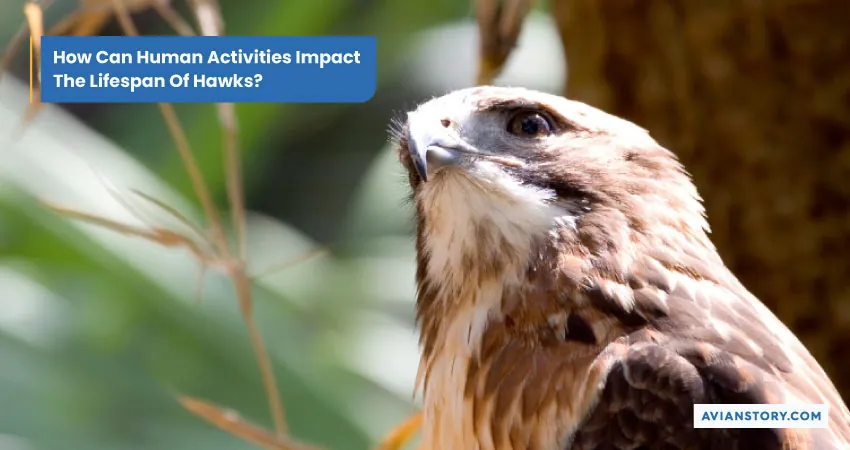
Human activities can have both direct and indirect impacts on the lifespan of hawks. Here are some ways in which human activities can affect the lifespan of hawks:
Deforestation And Habitat Loss
Human activities such as deforestation and land development will destroy their habitats. By cutting down the trees, you will cause loss of their suitable foraging areas, nesting sites, and hunting grounds.
Within a small habitat, there will be a limited amount of prey, which will cause a scarcity of food. This scarcity will lead to intense competition for food and increase their stress level.
Urbanization
People are cutting down forests for urbanization, which can impact hawks’ longevity in different ways. Here are a few examples:
- This will also increase the risk of collision of hawks with human-made structures. These collisions can result in severe injuries or fatalities.
- Noise and light pollution can hamper their sleeping cycle and affect their vitality.
Chemical Pollution
Generally, pesticides, fertilizer, and other chemical pollutants that you use in agriculture, industry, and households can contaminate the food chain. If these predatory birds ingest any poisoned prey, it will also cause poisoning in them.
Those chemicals will have detrimental effects on hawks’ respiratory, nervous, and immune systems. Eventually, it will reduce their reproduction success and lifespan.
Hunting And Trapping
Though hunting and trapping this bird species is illegal, if it perceives any risks to livestock, you can shoot them. Hunting, shooting, or poisoning them can directly cause their death.
Sometimes, you can trap them by attracting them. You can use pigeons, starlings, mice, grasshoppers, etc, as bait to attract the hawks toward the trap. After trapping, you can perform euthanasia on them.
Sometimes, you can also hand them over to any rehabilitation center where authorities may conserve them. Yet, the main perspective for hunting or trapping is to reduce their population in your respective areas.
What Are the Conservation Efforts In Place To Protect Hawks And Extend Their Lifespan?
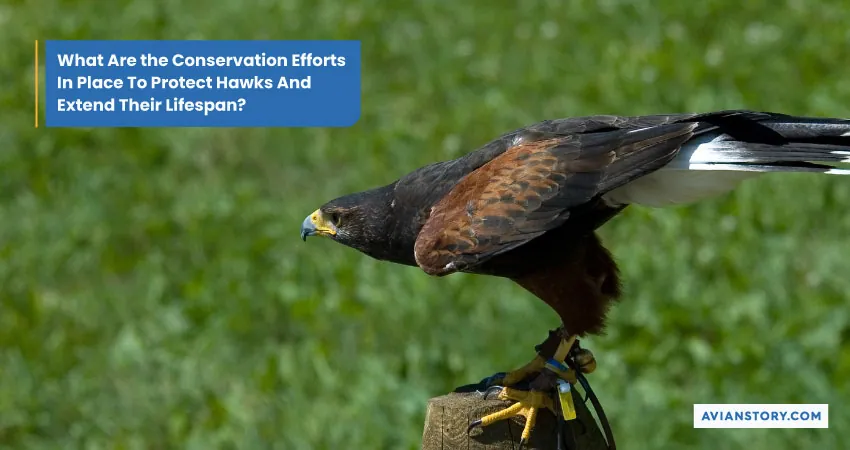
Let’s know first, are hawks endangered? Among 200 species of these birds of prey, only 20 are endangered.
However, to save them from extinction, proper conservation efforts are essential. Hawks are protected under several laws and conservation efforts.
Let’s know how these conservation efforts improve hawks’ lifespan:
Regulations On Hunting And Trapping
According to federal laws, you can’t hunt this predatory bird species unless they pose any threats to your livestock. If they pose any threats to your livestock, first, you need to apply for a permit to shoot them.
Even though you get permission, you can use any lethal method like trapping or poisoning to kill them. You can get under legal actions like imprisonment or a heavy fine for illegal hawk killing.
Restoration And Protection Of Habitats
Some conservation organizations like HawkWatch International, The National Audubon Society, etc, play a role in the protection of hawk habitats.
These organizations diagnosed the critical region of their habitats. Then they prevent deforestation in those areas and reduce pesticide use near those regions.
Besides, they also take steps of reforestation to restore hawks’ damaged habitats.
Captivate Breeding
To reduce the mortality risk, cultivating breeding is an impressive step. Organizations like the Zoological Society of London, and Durrell Wildlife Conservation Trust are playing a role in that. These organizations will breed the mating pairs of endangered species in captivity.
Then, they will raise the offspring and reintroduce them to their natural habitats. This effort increases the breeding success and reduces the risk of predation of the offspring in their vulnerable condition.
Spreading Awareness
The International Union for Conservation of Nature (IUCN) is taking steps to educate people about hawks’ importance in ecology. Besides, the Peregrine Fund is educating the general people about the consequences of pollution and habitat destruction on hawk longevity.
Also, if you are aware of the conservation campaigns, you will be interested in participating. These will reduce the potential risks of hawks; thus, they can live longer.
What Are Some Interesting Facts about the Longest Living Hawks?
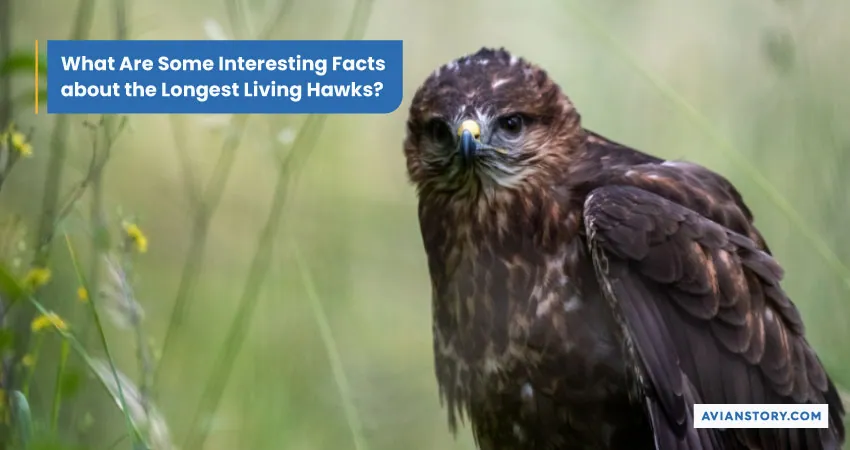
There are some of these bird species that have lived or lived more than their expected lifespan. Let’s know about those oldest Hawks facts:
- Pale Male: This red-tailed hawk hatched in 1990 and died on 16 May of 2023. It arrived in the Central Park of New York City in 1991. Since then, every spring, birdwatchers set up telescopes to watch it.
- Charlie: This is a red-tailed hawk that lived from 1981 to 2014. A male hawk was injured from a car collision when someone brought him to WSU. Since then, it has lived in the rehabilitation club of WSU.
- Cheyenne: This is a female Harris hawk who hatched around 1985. She lived in Freedom Centre for Wildlife of New Jersey. According to the last report of this bird, she celebrated her 36th birthday in 2021.
You can see that all of these oldest hawks are either red-tailed or Harris hawks that have large or medium-large sizes. Their large size is responsible for their slower aging and lower predation rate.
Besides, all of them live or live in captivity, where they have access to available food sources and a threadless and suitable environment.
How Do Hawk Lifespans Compare with Other Birds of Prey?
Here is a comparison of hawk lifespans with other raptors, such as eagles, falcons, and owls:
| Name of Raptors | Lifespan in the wild (Years) | Lifespan in captivity (years) |
| Hawks | 12 | 20-30 |
| Owls | 8-15 | Up to 38 |
| Eagles | 15-20 | 30-50 |
| Falcons | Up to 15 | Up to 25 |
| Osprey | 15-20 | 30-35 |
As you can see, hawks have a slightly lower average lifespan than those other raptors. The reasons for differences in lifespan among these species are:
- Size: Eagles and osprey are larger species than all of those species. Thus, they have slower aging and larger lifespans than those smaller size owls, hawks, and falcons.
- Hunting Strategies: If you compare hawks vs owls, you will find that owls are nocturnal bird species, whereas hawks are diurnal. Thus, predators like foxes or snakes target owls as they are vulnerable during day hours.
But other species of raptors are diurnal, so they have lower chances of getting hunted by those predators.
- Reproductive Strategies: In the eagles vs hawks reproduction rate, some hawks have higher reproduction rates than eagles. Even hawks and falcons may have lower reproduction rates than other raptor birds.
Their breeding efforts will cost a significant amount of energy, leading them to stress and a shorter lifespan.
Conclusion
How long do hawks live greatly dependson their species, size, genetic factors, and breeding success. Besides, climate change, pollution, predation, collisions with moving vehicles, diseases, etc., can also cause shortening of their lifespan.
However, some species of them are endangered, which may lead to their extinction and imbalance in the ecosystem’s food chain. That’s why conduct proper research to understand their importance, migratory and breeding behavior, and take proper steps to protect them.
